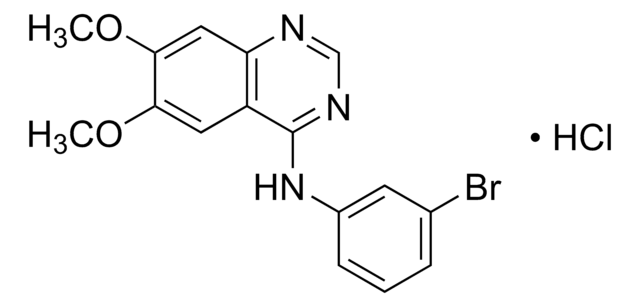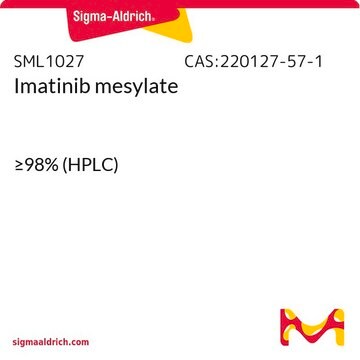おすすめの製品
product name
ゲフィチニブ, ≥98% (HPLC)
品質水準
アッセイ
≥98% (HPLC)
形状
powder
色
white to beige
溶解性
DMSO: 10 mg/mL, clear
保管温度
room temp
SMILES記法
COC(C=C(N=CN=C1NC2=CC(Cl)=C(F)C=C2)C1=C3)=C3OCCCN4CCOCC4
InChI
1S/C22H24ClFN4O3/c1-29-20-13-19-16(12-21(20)31-8-2-5-28-6-9-30-10-7-28)22(26-14-25-19)27-15-3-4-18(24)17(23)11-15/h3-4,11-14H,2,5-10H2,1H3,(H,25,26,27)
InChI Key
XGALLCVXEZPNRQ-UHFFFAOYSA-N
遺伝子情報
human ... EGFR(1956)
類似した製品をお探しですか? 訪問 製品比較ガイド
アプリケーション
- 子宮内膜癌治療におけるその効果的な使用を研究するため
- 細胞増殖、細胞周期およびアポトーシスアッセイ
- 細胞生存率アッセイおよびコロニー形成アッセイ
生物化学的/生理学的作用
ゲフィチニブは、ATPよりもEGFRチロシンキナーゼドメインのATP(アデノシン三リン酸)結合部位に対して高い親和性を有しています。そのため、ゲフィチニブは子宮内膜癌の進行を阻害することが知られています。
シグナルワード
Danger
危険有害性の分類
Acute Tox. 4 Oral - Aquatic Chronic 1 - Carc. 2 - Eye Dam. 1 - Repr. 1B - Skin Irrit. 2 - STOT RE 2 Oral
保管分類コード
6.1C - Combustible acute toxic Cat.3 / toxic compounds or compounds which causing chronic effects
WGK
WGK 3
引火点(°F)
Not applicable
引火点(℃)
Not applicable
適用法令
試験研究用途を考慮した関連法令を主に挙げております。化学物質以外については、一部の情報のみ提供しています。 製品を安全かつ合法的に使用することは、使用者の義務です。最新情報により修正される場合があります。WEBの反映には時間を要することがあるため、適宜SDSをご参照ください。
Jan Code
SML1657-10MG:
SML1657-VAR:
SML1657-BULK:
SML1657-50MG:
試験成績書(COA)
製品のロット番号・バッチ番号を入力して、試験成績書(COA) を検索できます。ロット番号・バッチ番号は、製品ラベルに「Lot」または「Batch」に続いて記載されています。
この製品を見ている人はこちらもチェック
ライフサイエンス、有機合成、材料科学、クロマトグラフィー、分析など、あらゆる分野の研究に経験のあるメンバーがおります。.
製品に関するお問い合わせはこちら(テクニカルサービス)

















